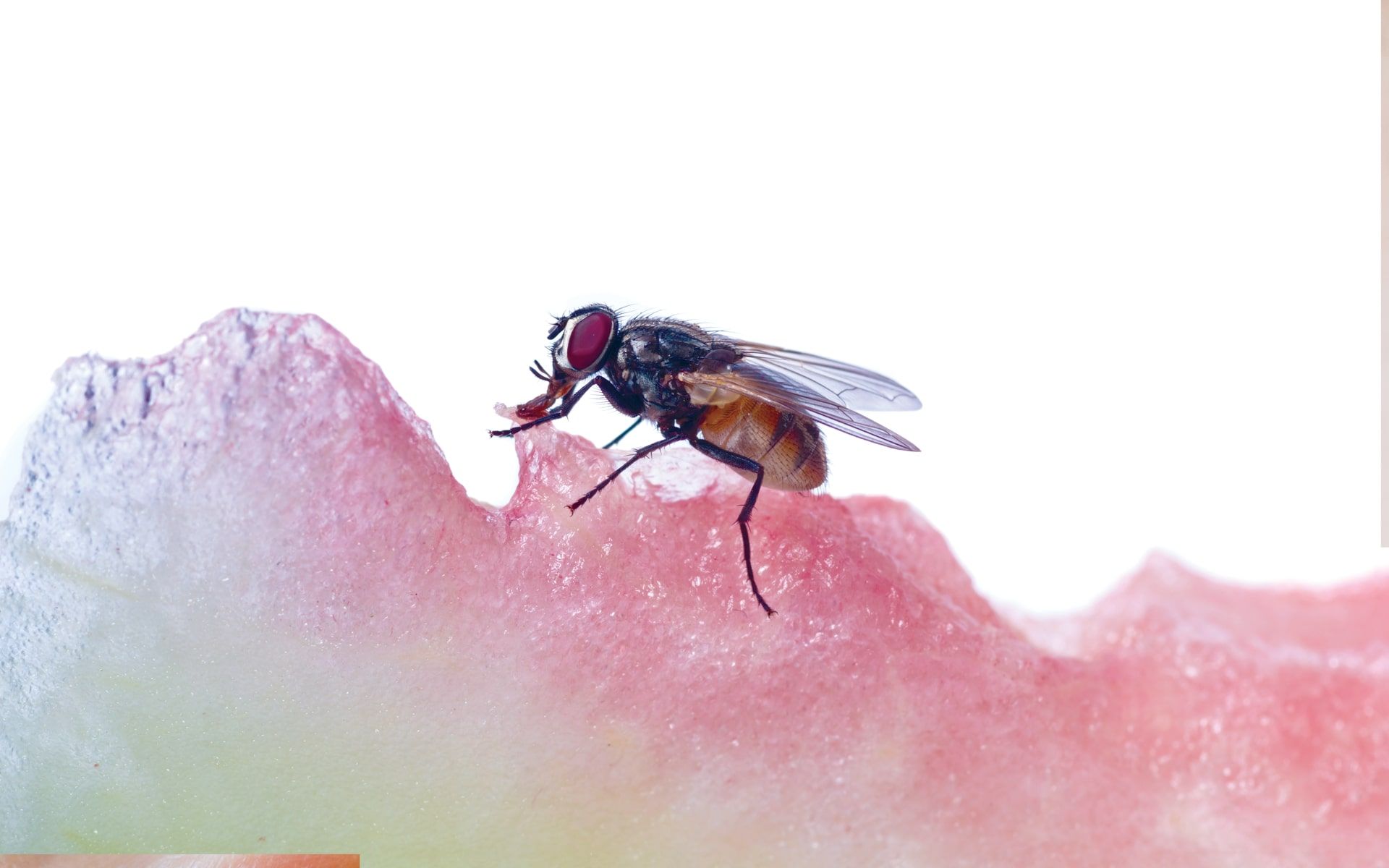Flies
- How can flies, which act as health workers that are charged with the duty of cleaning the world, digest so many diverse amounts of garbage and waste?
- Joanne Clarke's research showed that flies produce their own antibiotics, and this was tested on four different fly species.
- Researchers from Stanford University announced that they found a substance in flies that can improve the human immune system

In This Article
-
How can flies, which act as health workers that are charged with the duty of cleaning the world, digest so many diverse amounts of garbage and waste?
-
Joanne Clarke's research showed that flies produce their own antibiotics, and this was tested on four different fly species.
-
Researchers from Stanford University announced that they found a substance in flies that can improve the human immune system.
Athlete’s foot is a frequent infection that millions of people suffer from annually. I once had it during my military service where we had to wear boots almost an entire day. Once during a noon intercession, I performed my ablutions to pray and I placed my feet under the sunlight to dry them. I was also hoping that ultraviolet rays from the sun would be good for the infection. Soon, flies swarmed in between my toes. When I could not bear the excessive itching, I tried to kill the flies until I was stopped by a friend who reminded me of the great sage Bediuzzaman’s comments where he called flies “cleaning workers.” At that time, I also remembered Prophet Muhammad’s (peace be upon him) words on flies. So, I patiently endured the nuisance, and repeated the same procedure for the next three or four days. Eventually, my feet were healed and there was no trace of the fungi.
In one of his very interesting hadiths, the Prophet, peace and blessings be upon him, is reported to have said the following about flies: “If a fly falls into your drink, dip it into your drink, then throw it away, for on one of its wings is a disease, and on the other is a cure. It dips the wing with the disease to protect itself” [1]. This hadith has been a reason for much controversy mainly due to germ disease theory. According to Jonathan C. Brown, “even before modern medicine, the Hadith of the Fly was raising skeptical eyebrows and prompting Sunni defensiveness as early as the writings of Ibn Qutayba (d. 276/889)” [2]. Brown also mentions that this hadith “could be false or it could be true, since scientists used the flesh of a snake to help prepare antidotes to its poison” [3].
Before the microscope was invented it was impossible to define microbes or talk about the anatomy or microbiology of flies as we can today. However, the introduction of experimentation and observation as an important scientific method with the Renaissance served as a turning point in Western scientific revolution. Thus, the “proof-based medicine” conception that relies on experimentation and observation emerged as a precursor to today's medicinal and scientific research. The importance of perceptions that rely on causes relating to the material world in persuading the human mind cannot be denied. It is harder to make people believe in something unless they are provided with concrete results that appeal to our five senses. We should not rush to deny any claim solely based upon our preconceptions and prior knowledge without doing any research about it; rather, we should pass our judgment on it after experimentation and observation.
Some people may automatically reject the idea that when a fly falls in our food or drink that we should immerse this microbe-carrying insect completely and they may say that this would not eliminate the microbes. Indeed, it may sound reasonable to assume that this disgusting insect that feeds on all sorts of dirt would cause only diseases. If you have an ample supply of food or water and if you do not have the stomach for it, you can of course refrain from eating or drinking such a food or drink. But, you can hardly advise someone who has very little water or food in a desert or at the time of famine to throw away what they have because of a fly.
We should examine different types of flies in laboratory settings using the method of experimentation and observation. First of all, it is very difficult to prove that someone can contract an illness from eating food in which a fly had fallen into although he or she had immersed that fly completely in that food. If it is proven that someone becomes ill due to a fly's alighting in their food, then strong objections can be raised. If it is said that there many diseases caused by flies, no one will deny it. The point is not whether flies carry germs, but whether this advice for being protected from the germs carried by flies is correct or not. As a matter of fact, the advice by the Prophet seeks to protect us from diseases that may be caused by germs carried by flies. The great scholar Bediuzzaman’s words on flies also give us an alternative perspective to consider about these “tiny birds”:
“…Flies are dutiful about cleaning away noxious substances or germs that cause disease. By sucking up and absorbing harmful germs, they destroy them, and they cause noxious or poisonous substances to change into other harmless forms, thus preventing the spread of many contagious diseases. A sign that they are both laborers for health and cleansing operatives and chemists, serving many instances of wisdom, is the fact that they exist in extremely great numbers. For the things that are valuable and beneficial are multiplied.” [4]
The hadith of the Prophet and Bediuzzaman’s commentary encourage us to explore more about flies and whether they can be a source of healing in any way.
Flies are very ubiquitous on earth. There are approximately 125,000 species of flies, but only ten species live in our homes and are of concern to us. They feed on garbage and organic waste materials that act as a breeding ground for microbes such as bacteria, fungi, and viruses. The female fly lays down more than 100 eggs in the dung of some animals or in garbage. After one day, the larva emerges to feed on the surrounding organic materials. In two weeks, they become full-grown flies. In four generations, one female fly can lay 1.5 million eggs, but fortunately the majority die due to weather circumstances or become food for birds, reptiles, amphibians, and other insects. A fly can live for 60 days at most.
Given the ecological balance in nature, one comes to accept that there should be species that will remove all sorts of organic waste, garbage, dead animals or plants, and similar things by eating them. Houseflies feed on the rotting corpses of animals while female horseflies suck blood. How can flies, which act as health workers that are charged with the duty of cleaning the world, digest so many diverse amounts of garbage and waste?
Flies get their nourishment differently from other animals. What other animals do for digestion is done by flies outside their bodies. They do not have teeth-like structures in their mouths in order to chew solid, dry food and therefore have to turn such food into liquid form or split it into 0.45-mm or smaller pieces. In this liquid form, flies can easily suck up their food using their suitably shaped mouths. To do this, flies vomit a saliva-like liquid, containing enzymes and acids, and that disintegrates the solid food into something that can easily be digested in a couple of seconds. In this process, some of the microbes in that waste food can be disintegrated while the rest will be sent to the stomach.
These foods and microbes taken inside in the form of vomit are sent to a sac called a “crop” if they are not small enough to go through the digestive tract. Flies produce fresh saliva regularly during which the vomit moves between their mouths and crops. Eventually, the sufficiently liquefied food is sent to the stomach which contains enzymes and acidic content as well as partially disintegrated microorganisms.
What does scientific research tell us?
Based on the theory that flies must have remarkable antimicrobial defenses and resistance to survive the bacteria from rotting dung, meat, and fruit, a team at the department of biological sciences at Macquarie University in Australia set out to identify those antibacterial properties.
“Our research is a small part of a global research effort for new antibiotics, but we are looking where we believe no one has looked before,” said Joanne Clarke, who presented the group's findings at the Australian Society for Microbiology Conference in Melbourne.
Clarke's research showed that flies produce their own antibiotics, and this was tested on four different fly species. Such research may lead to better treatments for human infections from Escherichia coli and other virulent bacteria even, perhaps, Staphylococcus aureus (MRSA).
Upon preliminary results, a global pharmaceutical company decided to support the research over the next six months by trying to isolate antibiotic compounds from the material collected from the flies. The research team is trying to identify the specific antibacterial compounds. As antibiotics that will eventually be invented and chemically synthesized come from the body surface of flies, not from other fungi or bacteria, it is believed that any gene that gives resistance to microbes will not be easily transferred to pathogens and the new antibiotic form will have longer and more effective treatment duration [5].
Later, Russian doctors had developed interest in this topic and observed that flies contain many substances that can be more effective than traditional medications and certain fly larvae have very strong therapeutic effects [6].
Noting that flies should be kept away from hospitals, Professor Juan Alvarez Bravo at the University of Tokyo expressed his support for such research, saying, “But soon we will witness a rapid treatment for many diseases, which consists of extracts from flies” [7].
Some researchers at Auburn University of the United States discovered a protein in the fly’s saliva which can accelerate the lengthy process of healing wounds and chronic skin cracking. Entomologists Ed and Mary Cupp managed to isolate the protein which houseflies inject into their prey to increase blood flow in the skin of their prey. Mary Cupp and surgeon Steven Swaim demonstrated that surgical incisions, skin ulceration, and diabetic foot lesions treated with solutions that combine antibiotics and this protein heal faster and stronger than incisions treated with antibiotics alone [8, 9].
In another study, it was found that epithelial cells forming the inner layers of the front and back intestines of the fly protect it from the bacteria it swallows thanks to a special cuticular lining, and in this way, bacteria never directly touch the intestinal epithelium and cannot give any damage to it. In this study, it was noted that people nurtured a radical approach to flies and that fly control has been abused for the sake of human health, suggesting that flies may be the source of novel germicides that make use of their antimicrobial digestive enzymes, lysozyme, and antimicrobial peptides [10].
Viruses cause many diseases in cattle, sheep, and birds. These diseases include encephalitis, aphthous fever (foot and mouth diseases), and duck plague which can be transferred to people through infected animals. Some crops such as potatoes, tomatoes, bananas, and sugarcane can also be destroyed by viral infections.
Flies carry the viruses of many diseases which are consequently transferred to man's food, drink, and body. Of these viral diseases are common flu, measles, mumps, chickenpox, warts, yellow fever, infectious liver diseases, some cases of paralysis, some types of cancer, and some chronic diseases of the central nervous system.
El-Naggar, Zaghloul, from Egypt, indicates that some of the disease-causing viruses may directly infect living beings and cause damage to their cells, while there is a type of virus which infects bacteria cells known as “bacteriophage.” These viruses, which can kill the bacteria they infect in a short time, are known as “virulent bacteriophage.” Those viruses that do not kill the bacteria they infect are called “temperate bacteriophage” [11].
After a bacteriophage infects a bacterium, more than 100 viruses are released from that bacterium and each of these viruses can infect new bacteria. The spreading of infection may continue until all vulnerable bacteria cells die. After it was discovered that bacteriophages are parasites of bacteria, they started to be used in treating the diseases caused by bacteria. However, their use in this manner declined after the discovery of antibiotics. Yet, the interest in phage treatment was revived after the emergence of bacterial resistance to antibiotics [12].
Researchers from Stanford University announced that they found a substance in flies that can improve the human immune system [13].
The work by Rehab Mohammed Atta from the Microbiology and Immunology Department, National Research Center, Cairo, Egypt, is quite remarkable [14]. In this research, the extracts taken separately from the left and right wings of flies were used against the bacteria and fungi calculated on nutrient “agar” media in the laboratory. It was demonstrated there was both bacterial and fungal growth for the left wing extract plates while no bacterial or fungal growth was reported for the right ones.
Given the fact that the garbage and rotting corpses on which flies feed from contain numerous dangerous bacteria, it is quite reasonable that it contains antibacterial materials necessary for its survival. In this case, the fly's needs might be of service as sources of antibiotics that can prevent epidemics among human beings, and this may be the reason why they were created in the first place: not to be a source of nuisance but a source of healing for us.
Aj-Taili, et al., from the department of medical microbiology, Qassim University in Saudi Arabia, conducted an experiment using water, honey, and various fruit juices in different cups. They found no germ in the solution in which the whole body of fly was immersed while the solution in which only one wing of the fly was dipped indicated the presence of germs [15].
In sum, we can say that antibacterial materials produced in the bodies of flies protect them against the microbes in their environments and that these microbes can prevent epidemics among human beings. At the very least, this topic deserves in-depth research. Atta's study confirms the virtue of the hadith that says, “The best way to release this vital antidote is to dip the fly in a liquid because these substances are concentrated on the outer surface of the fly body and wing.” Abduldaem al-Kaheel refers to this study in his website: “This is logical because the fly has a lot of harmful bacteria on the outside of her body and therefore in order to continue in her life, it should also carry anti-bacterial materials; these materials were furnished by God to protect it from viruses and diseases.” In the light of these studies, the need for conducting more research for obtaining antibiotics from the right wing of the fly is clear [16].
References
- Abu Dawud, At'imah, 49. Also see Bukhari, Tib, 57, Bed'u al-Khalk 17; Ibn Majah, Tib, 31, Nasa'i, Far', 11.
- Brown, Jonathan A. C. 2009. Hadith: Muhammad’s Legacy in the Medieval and Modern World, p. 264.
- Ibid. p. 255.
- Nursi, Bediuzzaman Said. 2008. The Gleams. The Light, Inc. p. 376.
- Danny Kingsley, ABC Science Online, 1 October 2002, The new buzz on antibiotics. Clarke, J., Gillings, M. and Beattie, A. (2002). Hypothesis-driven drug discovery. Microbiology Australia, pp. 8–10.
- Petersburg State University, (2006). The fly effect: Russian Scientists Invent new medicine with the help of flies.
- Bravo, J. A. (1994). The ointment in the fly: antibiotics. New antibiotic derived from a common fly. The Economist (US).
- Ed and Mary Cupp (2005). Protein in Fly Saliva Speeds Healing of Incisions Wounds. Auburn University. R Am Ex Ars Medica, Inc., 7:23.
- Protein in Fly Saliva Speeds Healing of Incisions, Wounds 20-Jan-2005. www.newswise.com/articles/protein-in-fly-saliva-speeds-healing-of-incisions-wounds
- Nayduch, D. and Burrus, R.G. (2017). Flourishing in Filth: House Fly–Microbe Interactions Across Life History. Special Collection: Filth Fly–Microbe Interactions. Annals of the Entomological Society of America, 2017, Vol. 110, No. 1.
- El-Naggar, Zaghloul, (2010). Housefly Falls into One’s Drink! 09 September 2010. www.quranandscience.com/quran-science/sunnah-science/204-housefly-falls-into-ones-drink-274
- Aydogan, D.Y., Hadimli, H.H. (2016). Bakteriyofaj Tedavisi (Bacteriophage Treatment), Etlik Vet. Mikrobiyol. Derg.; 27 (1): 38–47.
- Stanford University Medical Center, 2007. Fruit Fly Insight Could Lead to New Vaccines. Science Daily. www.sciencedaily.com/releases/2007/03/070308220904.htm
- Atta, R. M. (2014): Microbiological Studies on Fly Wings (Musca domestica) Where Disease and Treat. World Journal of Medical Sciences 11 (4): 486–489.
- Aj-Taili, S.I., A.A.R. Al-Misnid and K.D. Al-Uteybi, (2002). Wing One and the Other Disease Carrying the Cure. Qassim University. Danny Kingsley.
- Abduldaem al-Kaheel, 1995. New facts: fly have a cure, www.kaheel7.com/eng.









